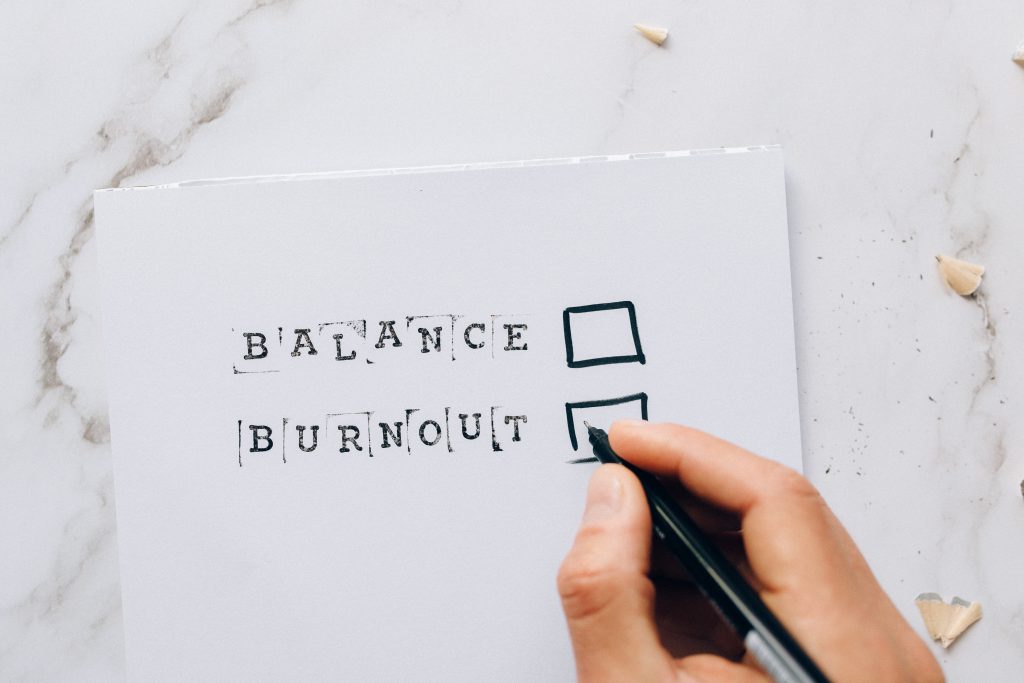
Photo by Nataliya Vaitkevich from Pexels
We all have our breaking points. During the last 18 months I have seen many strong, self sufficient people reach theirs. When key staff members experiences burnout the impact on the business can be huge. Recovery can take months or even years, during which time productivity suffers. At the beginning of Covid media attention was on ‘frontline worker burnout’ but now burnout effects every business and industry. This Gallup Poll from 2018 explores the severity of the impact of burnout before Covid struck.
Merriam-Webster dictionary defines burnout as “exhaustion of physical or emotional strength or motivation usually as a result of prolonged stress or frustration”
Understanding how to recognise Burnout in yourself and others allows you to both prevent burnout and recover from it.
Signs and Symptoms of Burnout
Everyone is struggling at the moment. People are dealing with so many ‘unprecidented’ situations that we live with constant uncertainty and anxiety. This fear and uncertainty constantly trigger our body’s Fight and Flight response. This response is designed for dealing with present moment emergencies. It mobilises the body for short term survival, but at the cost of long term survival. Our immune system is put on the back burner, digestion is put on the back burner, sleep is put on the back burner.
This eventually leads to body and mind exhaustion while the Fight and Flight response continually triggers. We run out of energy but can’t recharge. We run out of hope and can’t snap out of it.
The following list of major symptoms can help to assess whether burnout has occurred.
- Chronic fatigue
- Insomnia
- Impaired concentration/ forgetfulness
- Anxiety
- Increased illness
- Physical symptoms
- Chest pain
- Shortness of breath
- Dizziness
- Gastrointestinal pain
- Depression
- Interpersonal problems
One hallmark of burnout is a short fuse. Other people and their needs feel like just too much for us to handle and we respond with irritability, withdrawal and aggression.

Mindfuness Practices for Burnout Awareness
Mindfulness practices allow us to accurately assess our own and other’s degree of burnout. This knowledge is required before we can take any remedial action.
Releasing Body Tension
Chronic tension is quickly ignored in our minds, which prioritise paying attention to novel or changing stimuli. Mindful body awareness helps us develop awareness of chronic tension.
It is best practised sitting down with eyes closed, but ideally we want to maintain our awareness of body tension throughout the day. Once you can identify tension you can start to consciously release it.
- Bring your awareness to the centre of the tension you feel, whether that is in your shoulders, neck, chest, forehead, etc.
- Breathe slowly and deeply into your belly, consciously relaxing on each outbreath
- Silently repeat “Let Go” to yourself on each outbreath
- Continue for 5 minutes or until the tension has unlocked.
Dealing with Exhaustion
There is a difference between exhaustion and tiredness, and that difference is that exhaustion is a tense state, whereas tiredness is a relaxed state. Consciously releasing tension allows the body to rest deeply and to recover.
- Scan your body for tension – the more you do this the greater your acuity becomes.
- Breathe slowly and deeply into your belly
- Silently repeat “Let Go” to yourself on each outbreath
- Continue until asleep or at ease
Notice burnout thinking
The key here is to label any thoughts that you have that are either
- Cynical
- Hopeless
- Anxious
- Angry
Whenever you notice these thoughts, do not engage with them, don’t fight them, don’t argue with them, simply label them and move on. Say to yourself “anger” and move on.
Tips and Reminders for recognizing burnout
Pay attention to body tension and develop the skills to reduce it.
Pay attention to your thoughts, especially cynical, angry and hopeless thoughts.
Correctly applied, mindfulness assists us in recognising and responding to burnout.
If you feel that burnout might be a concern for your company or yourself, contact Steven Hudson steve@oceansoflight.org to set up a meeting to discuss your needs and how Oceans of Light can help.
